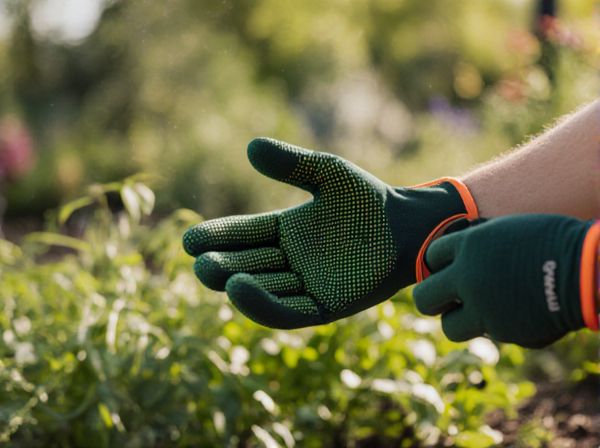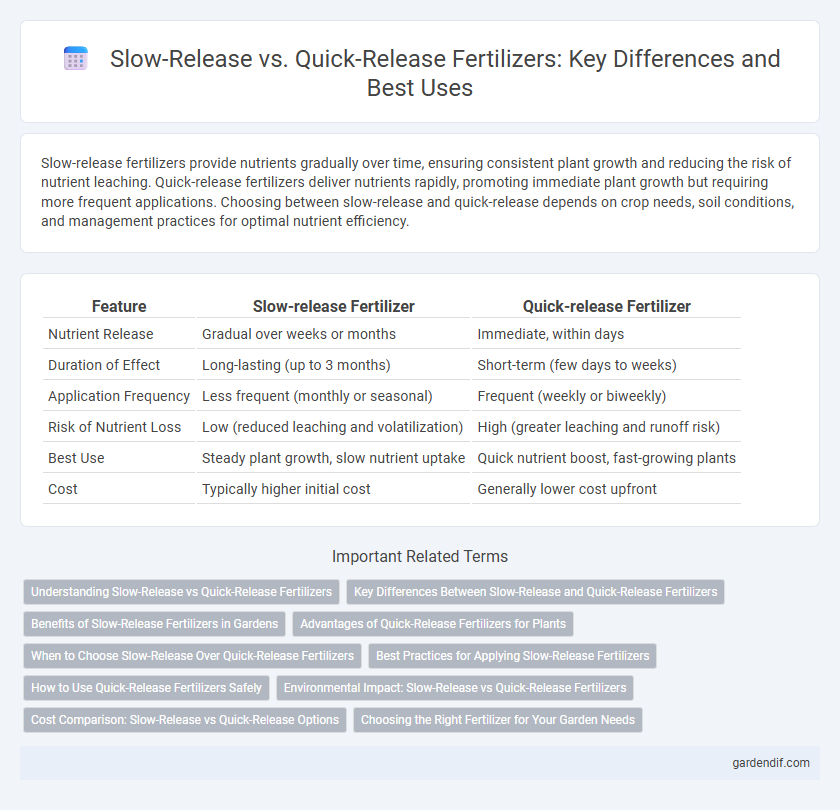
Slow-release vs Quick-release Illustration
Slow-release fertilizers provide nutrients gradually over time, ensuring consistent plant growth and reducing the risk of nutrient leaching. Quick-release fertilizers deliver nutrients rapidly, promoting immediate plant growth but requiring more frequent applications. Choosing between slow-release and quick-release depends on crop needs, soil conditions, and management practices for optimal nutrient efficiency.
Table of Comparison
| Feature | Slow-release Fertilizer | Quick-release Fertilizer |
|---|---|---|
| Nutrient Release | Gradual over weeks or months | Immediate, within days |
| Duration of Effect | Long-lasting (up to 3 months) | Short-term (few days to weeks) |
| Application Frequency | Less frequent (monthly or seasonal) | Frequent (weekly or biweekly) |
| Risk of Nutrient Loss | Low (reduced leaching and volatilization) | High (greater leaching and runoff risk) |
| Best Use | Steady plant growth, slow nutrient uptake | Quick nutrient boost, fast-growing plants |
| Cost | Typically higher initial cost | Generally lower cost upfront |
Understanding Slow-Release vs Quick-Release Fertilizers
Slow-release fertilizers gradually supply nutrients over an extended period, reducing nutrient leaching and promoting steady plant growth, making them ideal for long-term crop nutrition. Quick-release fertilizers provide immediate nutrient availability, supporting rapid plant development but requiring more frequent applications to avoid nutrient loss. Choosing between slow-release and quick-release formulations depends on crop type, soil conditions, and specific nutrient management goals.
Key Differences Between Slow-Release and Quick-Release Fertilizers
Slow-release fertilizers gradually supply nutrients over an extended period, reducing nutrient leaching and enhancing plant uptake efficiency, while quick-release fertilizers deliver nutrients rapidly for immediate plant needs but carry a higher risk of nutrient loss through runoff. Slow-release formulations often use coated granules or organic materials to control nutrient availability, whereas quick-release types typically contain readily soluble chemical salts such as ammonium nitrate or urea. Understanding these differences is crucial for optimizing fertilization strategies in agriculture and gardening to balance plant growth requirements and environmental sustainability.
Benefits of Slow-Release Fertilizers in Gardens
Slow-release fertilizers provide a steady supply of nutrients, promoting healthier root development and reducing the risk of nutrient burn in garden plants. Their gradual nutrient release minimizes leaching and runoff, enhancing environmental sustainability and soil health. This controlled feeding supports consistent plant growth, leading to higher yields and more vibrant blooms compared to quick-release fertilizers.
Advantages of Quick-Release Fertilizers for Plants
Quick-release fertilizers provide immediate nutrient availability, promoting rapid plant growth and quick correction of nutrient deficiencies. Their solubility ensures nutrients are easily absorbed by plant roots, enhancing early development and boosting overall productivity. This type of fertilizer is especially beneficial for fast-growing crops requiring prompt nutrient supply to maximize yield.
When to Choose Slow-Release Over Quick-Release Fertilizers
Slow-release fertilizers are ideal for plants requiring steady nutrient availability over an extended period, such as perennials and lawns, reducing nutrient leaching and minimizing the risk of root burn. Choose slow-release options for environments where frequent fertilization is impractical or where nutrient runoff may harm surrounding ecosystems. Quick-release fertilizers suit fast-growing crops needing immediate nutrient uptake but can cause rapid nutrient depletion and require more frequent application.
Best Practices for Applying Slow-Release Fertilizers
Applying slow-release fertilizers involves evenly distributing granules around the root zone to ensure steady nutrient availability over extended periods, typically 8 to 12 weeks. Incorporate the fertilizer into the soil lightly to improve nutrient absorption and reduce runoff, especially in sandy or porous soils. Adjust application rates based on soil tests and crop nutrient demand to optimize growth while minimizing environmental impact.
How to Use Quick-Release Fertilizers Safely
Quick-release fertilizers provide nutrients rapidly, making them ideal for immediate plant growth, but require careful application to avoid root burn and nutrient runoff. Applying these fertilizers in small, precise doses near the plant roots and watering thoroughly can enhance nutrient absorption while minimizing environmental impact. Always follow label instructions and consider soil tests to determine appropriate quantities for safe and effective use.
Environmental Impact: Slow-Release vs Quick-Release Fertilizers
Slow-release fertilizers minimize nutrient runoff and reduce leaching, lowering the risk of water contamination and eutrophication compared to quick-release fertilizers. Quick-release fertilizers release nutrients rapidly, which can lead to spikes in nutrient concentrations that harm aquatic ecosystems and increase greenhouse gas emissions. Choosing slow-release options enhances soil health and supports sustainable agricultural practices by providing a more controlled nutrient delivery.
Cost Comparison: Slow-Release vs Quick-Release Options
Slow-release fertilizers typically have higher upfront costs due to their advanced coating technologies but reduce the frequency of application, potentially lowering long-term expenses. Quick-release fertilizers are generally cheaper initially but may require more frequent application, increasing labor and material costs over time. Evaluating total cost-effectiveness involves considering nutrient efficiency, crop yield, and application frequency.
Choosing the Right Fertilizer for Your Garden Needs
Slow-release fertilizers provide a steady nutrient supply over weeks or months, reducing the risk of nutrient leaching and root burn, ideal for plants requiring consistent feeding. Quick-release fertilizers deliver nutrients rapidly, supporting fast growth and immediate nutrient deficiencies but demand more frequent applications. Selecting the right fertilizer depends on soil type, plant species, and growth stage, balancing nutrient availability with environmental impact.
Slow-release vs Quick-release Infographic

 gardendif.com
gardendif.com